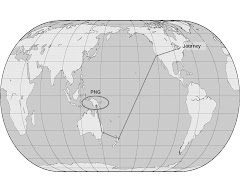From the moment we cross the river, we are greeted by the village people – and what friendly people they are. In pairs and in groups they meet us, expecting our arrival and are eager to see us.
There are mothers with little ones trailing behind or sleeping, lengthwise, in bilum bags slung around their shoulders or foreheads. They are usually barefoot and the dark skin of their feet and legs looks almost chalky, especially the children, being closer to the dusty ground. Their well worn clothing is very Western (except for their mariblauses) – not only in style, but also in content: many children wear shirts with American or European team logos; there are one or two Spiderman shirts; there is even an old woman wearing a Bob Marley shirt – obviously hand-me-downs from visitors past and present.
Most of the women wear long mariblauses over their long skirts, though western pants beneath the mariblauses are beginning to creep into the culture.
Pastor Hamm greets us at the riverside and he leads us in our growing parade across the fallen tree-bridge, up the steep hillside to the village area. We pass a small group of huts with grass roofs and thatched walls, and continue on a straight, carefully dug out path between two parcels of farmland. We are told that rice was planted on one of them.
As we approach our destination, we are greeted by a larger throng – mostly women, children and old men – holding a homemade sign: “Welcome to Ba’e Church.” They line our path and greet us, one by one. ”Name bilong yu?” they ask after introducing themselves. Even our “pikininni”, John, Nick and Tim, are asked. They all shake our hands and many hugs are exchanged. This could have been a twenty minute walk, if not for their warm greetings. These are prolonged, joyously, by their reunions with Ingrid, Tony and Donna, who were here on earlier visits.
Having reached the church, we settle in for a time of ministry. Ingrid and Donna gather in the old church with the women of the village and some of the older boys and men. Ingrid shares her testimony of God’s rescues – including from her abandonment as a baby and her adoption, especially by God her Father through her faith in Jesus Christ.
For by grace you have been saved through faith. And this is not your own doing; it is the gift of God, not a result of works, so that no one may boast. – Ephesians 2: 8-9
Next door in the shade of the new church (still being built), Becky, Marylou, John, Nick and Tim minister to the children through songs of faith and God’s love. Then a time of teaching. Our theme for the children is courage, and Marylou begins by telling the story of the Jewish heroine Esther, who rescues her people from an early holocaust by putting her life on the line to save them: “If I die, I die,” she reasons. Her story is a foreshadowing of the ultimate rescue (for those who believe) by Jesus, who gave his life as a ransom for many.
A time of celebration follows an exchange of gifts to the children – theirs and ours. The old man, Obo gives bows and arrows to our boys and Pi'i gives us a carved pig decoration. He recently received Jesus as his savior.
After returning to the missionary center, the day is well spent, but it is capped by the social event of the season. Bruce conducts the middle and high school marching bands in a concert for the center. Peter takes part on French horn. It was an excellent performance and a perfect way to end the day.


